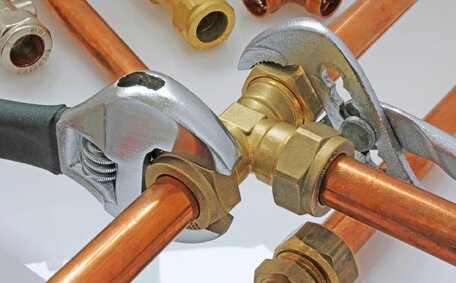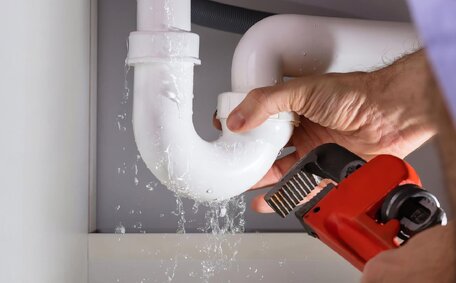What causes a blocked shower drain?
Several factors commonly lead to blocked shower drains:
Hair buildup
As we wash and rinse our hair in the shower, strands inevitably get left behind, collecting over time. Strands of hair can clump together with soap residue, obstructing water flow through the drain pipes.
Soap scum
The residue from shampoos, body washes and soap bars often leaves behind a substance called hair soap scum, especially in hard water areas. This coats your pipes and mixes with hair and soap, creating stubborn clogs.
Dead skin cells
Drains can get clogged with constantly shedding dead cells that get washed down the drain. These cells can accumulate and cause blocked shower by restricting water flow down your drain.
Dirt and debris
Bits of dirt, leaves, tree roots, dust and other debris tracked into your bathroom can cause a blocked drain.
By grasping the most frequent sources of shower drain clogs, we gain insights on how to take even more precise steps to clear out blockages requiring regular cleaning and maintenance.
Preventing shower drain clogs
To help prevent and unblock your shower drain clogs:
Install a drain cover or strainer
Knowing how unblock shower drain effectively using a drain cover or hair catcher is among the best preventative steps you can take. It’s essential to regularly clean the drain plug or strainer to prevent blockages.
Limit hair and product buildup
Reduce residue accumulation by employing proper methods to clean drain and prevent it getting clogged up and shower surfaces after each use. Adopt drain hygiene practices such as collecting loose hairs from your hands and body and disposing of them in the bin instead of allowing them to enter your drains.
Clean the drain regularly
Conduct monthly maintenance by flushing your drain with a mixture of baking soda and vinegar, followed by 2-3 litres of boiling water to dissolve any buildup. Avoid harsh chemical cleaners that may damage your pipes.
Use a drain snake
To learn how fix your shower drain with periodic deep cleaning, use a drain snake/auger to extract accumulated debris and hair from deeper within the pipe. Exercise caution to prevent any potential damage like scratching or a burst pipe as you tackle your blocked shower.
Quick fix methods for unclogging a shower drain
Before seeking professional help, consider these home remedies for minor shower drain blockages:
Boiling water
Boiling 1-1.5 litres of water and gradually pouring it into the drain can dissolve minor blockages. A baking soda and vinegar mix can also tackle soap or grease obstruction.
Baking soda and vinegar
Introduce a half cup of baking soda and then an equal measure of vinegar into the drain, covering it for 5-10 minutes to let the fizzing reaction disintegrate the blockage. Flush with hot water to clear any residue.
Plunger
For a sealed environment, use a wet rag over the drain before employing a plunger in an energetic pumping motion to release the blockage.
Drain snake/auger
A drain snake can access deeper clogs, extracting hair and debris lodged within. Ensure you navigate gently to avoid scratching the pipes.
Attempt these DIY solutions initially to resolve a blocked shower drain. But if you’re on the Sunshine Coast and the clog persists, you can try reaching out to our local plumbing services; plumbers which are very professional can properly diagnose and can clear the blockage to make you very happy.
Using a plunger
Here are the steps for using a plunger to unclog a shower drain:
1. Cover the overflow holes
Most shower drains seem like they have overflow holes, prompting the thought 'What do I do now?' around the rim. Stuff rags or a towel into these holes to ensure a tight seal when you place the plunger over the drain.
2. Fill the bathtub with some water
Pour enough water to cover a couple of inches into the tub - this assists the plunger in addressing your clogged drain more effectively by compressing and expanding the water to generate force.
3. Seal the plunger over the drain
Press the plunger firmly up down over the drain opening, a task you can easily perform, to form an airtight seal around the edges.
4. Plunge vigorously
Work the plunger up and down rhythmically 10-15 times, a technique often used in your water system, to forcefully dislodge the drain clog. The pressure changes can drain shower clogs and clear your blockage.
5. Remove the plunger and flush with hot water
Take off the plunger and pour a pot of boiling water down drain to get rid of the clogged shower drain. This can help flush away any remaining debris down drain.
Using some force with a plunger can be effective for clearing blockages located near the drain opening. But to unclog a shower when clogs are further down the pipe, reaching for a drain snake or calling a plumber may be necessary.
Pouring boiling water
Boiling water can be an effective DIY method for clearing soap scum, hair, and grease that your shower drain can accumulate.
Safety first
When pouring boiling water, safeguard yourself by wearing gloves, and carefully pour to prevent splashes and burns.
Technique
Boil about 4 cups of water and steadily pour it over the baking soda in the drain. Allow it to dissolve the buildup for a minute.
Repeat as needed
You may need to repeat the process a few times on your own to fully clear the clog. Allow a couple of minutes between each boiling water treatment for the drain to cool down.
Finish with a flush
After pouring the boiling water, flush drain with cool water to rinse away any dissolved debris. This technique assists in ensuring waste materials properly drain away, preventing future buildup.
While boiling water is useful for clearing minor blocked drains close to the drain opening, more serious blockages often require a professional plumber with specialised drain cleaning equipment.
Baking soda and vinegar treatment
Baking soda and vinegar is a natural and effective remedy for clogged shower drains. This mixture chemically reacts to break down substances like soap scum, oil, grease, and hair within clogged drains.
What You’ll Need:
- 1 cup baking soda
- 1 cup white vinegar
- Kettle or pot for boiling water
- Plunger (optional)
Step-by-Step Instructions:
- Start by removing the drain cover and stoppers to ensure full access.
- Pour about 1 cup of baking soda generously into the drain. Ensure all the soda and vinegar mixture makes its way down into drain.
- Follow up by slowly pouring a cup of white vinegar down the drain. Be careful, as it will fizz and bubble from the chemical reaction.
- Place a damp rag or towel over the drain opening to contain the reaction.
- Let the baking soda and vinegar mixture sit for 5-10 minutes to take effect. It will break down buildup that is clogging the drain.
- Boil a full kettle of water and pour hot into the drain. Pour the boiling water into the drain carefully to wash away loosened debris.
- Optional: Use a plunger to forcefully plunge the drain 10-15 times and help dislodge the clog.
- Flush the drain well with cool water.
Weekly use of baking soda and vinegar can maintain a clear shower drain by removing grime and preventing clogs. For persistent or severe blockages, professional plumbing services may be necessary.
Snaking the drain
Using a drain snake, also known as an auger, is an effective way to clear blockages deep within shower drain pipes. A drain snake is a specialised tool designed to physically remove clogs by reaching into the drain line and pulling out accumulated debris and hair.
How to use a drain snake:
- If a drain snake isn’t handy, a straightened coat hanger can be an alternative tool. Gently insert it into the drain, twisting to navigate around clogs.
- Once resistance is felt from a clog, twist the snake in a clockwise direction while applying gentle pressure to work the hook through the debris and remove hair.
- Once you overcome resistance, withdraw the snake slowly, bringing out the entangled hair and debris responsible for the blockage.
- Remove any loosened debris from the hook and continue feeding the snake into the pipe to reach any remaining clogs.
- After snaking the full length of pipe, run hot water to help any remaining particles come out.
Cautions when using a drain snake:
- Handle the process delicately to avoid scratching or harming the pipes.
- Only apply gentle pressure and twisting motion to work through clogs - forcing the snake can harm pipes.
- Slowly pull out debris to avoid it breaking apart and re-clogging further down.
An accurate application of a drain snake effectively clears severe clogs. However, persistent or hard-to-reach blockages should be addressed by expert plumbers.






